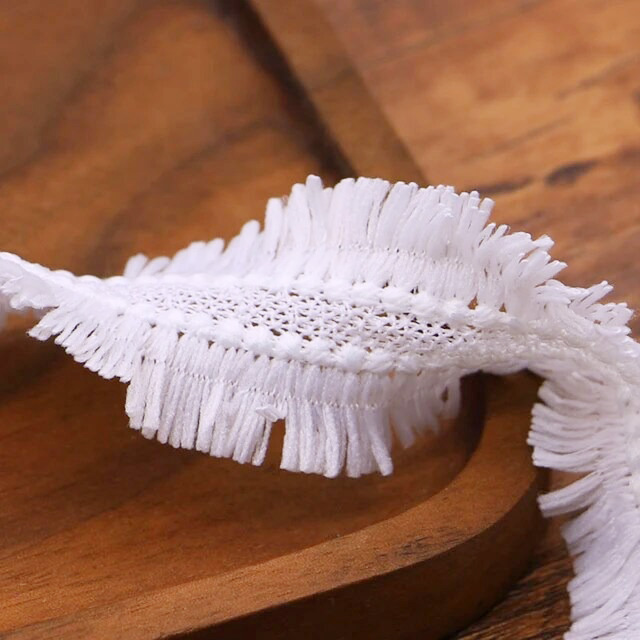Caring for Cotton Fringe Lace products mainly focuses on preventing fray, deformation, and color fading to maintain their delicate texture and appearance. Below are expanded, actionable tips for each care step, including solutions to tricky issues like tangled fringe or stubborn stains.

The biggest risks here are frayed fringe and damaged lace holes, so every step needs precision.
Avoid all "heavy-duty" detergents (e.g., those for sports stains or whitening). They contain enzymes or bleaching agents that break down cotton fibers over time, making lace thin and fringe brittle.
Opt for pH-neutral detergents (look for "pH 7" on the label) or specialized lace cleaners. Baby shampoo also works in a pinch—it’s mild and won’t leave residue.
30°C (86°F) is the maximum. Even slightly warmer water (e.g., 40°C) can cause cotton to shrink subtly, which warps the lace’s pattern and makes fringe uneven.
Use cold water for colored Cotton Fringe Lace. Hot water can cause dye bleeding, especially if the product is new (always do a "color test" first: dip a small, hidden part of the lace in water and check for dye on the cloth).
If fringe is tangled, gently comb it out with a fine-tooth comb (like a baby hair comb) before washing. Start from the bottom of the fringe and work upward—never yank, as this will pull out threads.
For severely tangled fringe, spritz a tiny amount of water (or diluted conditioner) to soften the fibers, then comb slowly.
Residue from detergent makes lace stiff and attracts dust, so rinse 2–3 times. After the last rinse, squeeze gently and check if the water runs clear (no suds = clean).
Do not soak the product for more than 10 minutes. Prolonged soaking can loosen the lace’s weave and make fringe threads fall out.
Most people skip small drying steps, but they’re key to keeping fringe neat and lace intact.
After washing, lay the product flat on a clean, absorbent towel. Roll the towel and product together (like a burrito) and gently press to squeeze out water. This avoids twisting (which stretches lace) and soaks up moisture without damaging fibers.
Never wring the fringe directly—hold the "base" of the fringe (where it attaches to the lace) and squeeze softly to prevent pulling threads loose.
Use a drying rack with a mesh surface (not a solid plastic one). Mesh lets air circulate evenly, preventing mold from growing on the back of the lace (a common issue with solid racks).
For products with long fringe (e.g., a dress hem), hang the top of the product on the rack (use soft clips, not metal ones that rust) and let the fringe hang freely. This keeps fringe straight instead of crumpled.
If the product was left in sunlight and faded slightly, mix 1 cup of cold water with 1 tablespoon of white vinegar. Gently dab the faded area with a cloth soaked in this solution (test on a hidden spot first!). Vinegar helps set remaining dye and reduces discoloration—do not rinse, just let it air dry.
Ironing is the trickiest step—even small mistakes leave permanent marks on delicate lace.
For thin, lightweight cotton fringe lace (e.g., on underwear or scarves): Use the "low" setting (110°C–120°C). High heat will scorch the thin fibers.
For thicker cotton lace (e.g., on tablecloths or jackets): Use the "medium-low" setting (130°C–150°C). Still, always test on a hidden edge first—if the lace starts to "shine," the temperature is too high.
1. Iron the back of the lace first (the non-decorative side). This protects the front pattern from direct heat.
2. For the fringe: Hold the iron 1–2 inches above the fringe and use the "steam burst" function (if your iron has it) to smooth wrinkles. Do not press the iron directly on fringe—it will flatten the threads and ruin their "flowy" look.
If you see a light scorch mark, mix a little baking soda with water to make a paste. Gently dab the paste on the mark with a soft cloth, then let it air dry. Wipe off the paste—this often fades the mark (do not rub, as it will damage the lace).
Small daily habits and quick fixes can extend the life of your cotton fringe lace products.
Clothing (e.g., dresses, blouses): Hang them in a garment bag with a wide, padded hanger. The padding prevents the hanger from leaving creases on the lace neckline/cuffs. For long fringe, make sure the fringe doesn’t touch the bottom of the bag—fold the fringe up slightly and pin it (with soft silk pins) to the inside of the bag to keep it straight.
Home Textiles (e.g., tablecloths, pillowcases): Fold them with a layer of acid-free tissue paper between each fold. Acid-free paper prevents yellowing (regular paper has acids that stain cotton over time). Avoid stacking heavy items on top—this crushes the lace and makes creases hard to remove.
If a fringe thread starts to fray, trim it with sharp, small scissors (e.g., nail scissors) at a 45° angle. Do not pull the thread—this will unravel more of the fringe.
For loose lace threads: Use a needle with a thin thread (matching the lace color) and tie a tiny knot at the end of the loose thread. Push the needle through the back of the lace (hiding the knot) and trim any excess—this secures the thread without leaving a visible mark.
Do not wear cotton fringe lace clothing while applying perfume or hairspray. These products contain alcohol, which discolors cotton and makes fringe stiff.
For home textiles: Keep them away from sharp objects (e.g., table edges, pet claws) that can hook and tear the lace holes.